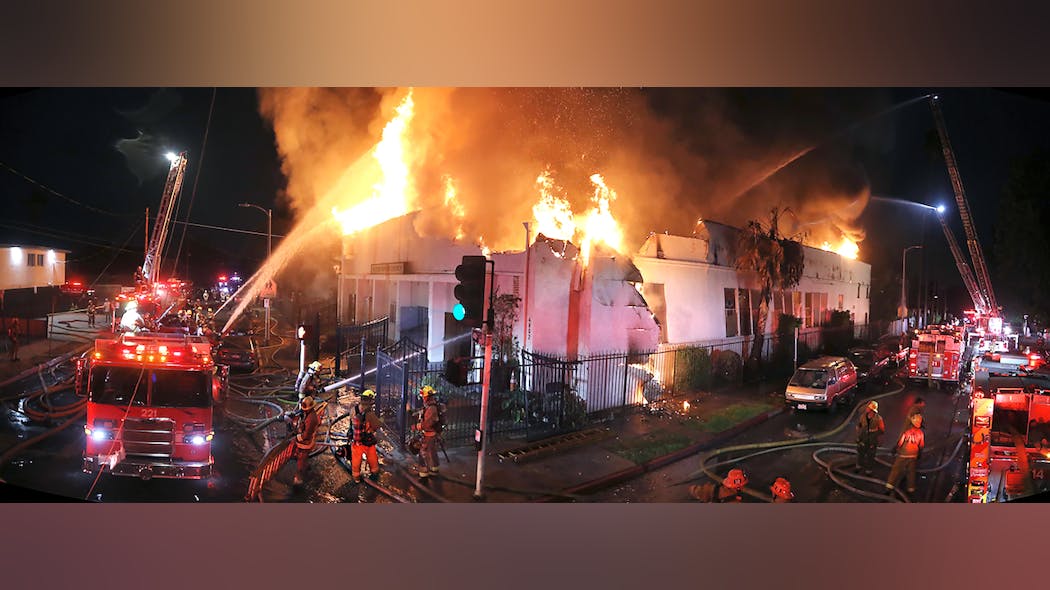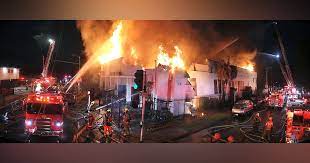March 13, 2023 Two Los Angeles firefighters hurt at the Victory Baptist Church blaze are still sidelined.
By Thomas Curwen Source Los Angeles Times (TNS) Distributed by Tribune Content Agency, LLC.

LOS ANGELES — Less than 90 seconds after the bedside alarm broke the spell of sleep, Los Angeles Fire Department Battalion Chief Gregg Avery and his partner, Chris Klimpel, were racing out of Station 13 through the streets of Pico-Union toward Victory Baptist Church.
Their command vehicle’s lights scoured darkened storefronts. Their siren chased cars to the curb. South on the 110 Freeway, traffic was light.
Avery, 62, and Klimpel, 49, were in the 20th hour of their 24-hour shift, another day at work for the veteran firefighters with nearly 57 years of experience between them battling blazes in Los Angeles.
Yet as skilled as they are, the next half-hour would prove once again how unpredictable the most routine calls are and how quickly they can turn potentially fatal.
Avery’s and Klimpel’s recollections of that night — Sept. 11, 2022 — and a summary report by LAFD provide a harrowing account of the 30-minute battle to save the historic church. It drew upon the efforts of 150 firefighters who swarmed the property that over the course of its nearly 80 years had hosted renowned politicians, civil rights advocates and gospel musicians.
Radios, TV monitors and satellite phones in the command vehicle gave Avery and Klimpel a picture of what lay ahead. The LAFD report excerpted a few broadcasts.
“IC from SQ21, we have made entry off the Charlie side. I am going to come up front and open that door for you from the inside. First floor has smoke, no active fire inside.”
Using a rotary saw, firefighters had cut a padlock on the gate, gotten inside the fenced perimeter, forced open the side door and swung open the main doors.
Firefighters, ascending aerial ladders, had tested the roof’s strength with specialized hooks, then opened a section with a chain saw and scanned inside with a thermal imaging camera.
The fire had been burning for nearly an hour, according to the LAFD report, which placed its origin in “the crawl space underneath the raised foundation.” Flames soon rose into the attic, crowded with rafters and sheathing.
Avery, who has conducted training seminars for the department, explained the physics.
Unchecked with ample fuel and oxygen, a fire will double in size every 60 seconds, he said. Getting hotter, it soon reaches 1,128 degrees, and carbon monoxide in the smoke combusts — a flashover — propelling flames further.
Inside the attic, wood ignited, stressing and popping from the heat. Chicken wire, nailed to the joists and holding in place the thick plaster ceiling, weakened, all before anyone was on the scene. The 911 calls came at 2:22 a.m.
‘We’re pulling heavy fire’
Avery and Klimpel arrived at 2:32 a.m. The street was crowded with several ladder trucks, engine companies, a command vehicle and an ambulance. A major emergency fire, it drew upon nearly 15% of the department’s citywide workforce typically on duty each day.
Stepping out of the truck, Avery looked up and saw flames and smoke pluming into the night sky. He heard chain saws on the roof.
The job that night was straightforward, he recalled: Attack the fire, protect the property and make sure everyone stays safe. The strategy was routine: open from above (to vent the smoke), attack from below (with water from hoses).
But he and Klimpel knew the odds were long for saving the building.
“Historically, churches and supermarkets are losers,” Avery said: too much roof, too much open space. The fire develops quickly, burning hot and fast, before anyone notices.
“It’s well ahead of us by the time we get there,” Klimpel said.
An update on the tactical channel from the roof confirmed the worst. “We’ve got multiple holes. We’re pulling heavy fire.”
Avery sloughed into his heavy jacket, pulled on helmet, gloves and breathing apparatus. He checked in with the incident commander, who assigned him and Klimpel to a second-story annex, connected to the church in the back.
Before joining the firefighters who were already working that part of the fire, Avery stepped inside the church, its sanctuary. He needed to check in with the battalion chief.
A large hole in the ceiling allowed light from the fire to illuminate a succession of pews. Smoke wafted above his head.
Initial efforts to open the ceiling with 12-foot pike poles had failed. The heavy plaster, mixed with Portland cement, more than three inches thick and applied to a lath of chicken wire, required an ax to break through.
Two firefighters stood on 20-foot extension ladders and fought the flames in the attic, trying to establish a horizontal line to sweep the fire with water. Two others managed the hoses at the base of the ladders. A fifth was pulling additional hose into the church.
Avery tried not to think about the loss of this church, the center of so many people’s lives. Instead, he was calculating the risk.
Two years ago, more than 230 firefighters fought a fire on Boyd Street in downtown Los Angeles. An explosion severely injured 11, some of whom are still not back at work.
“A building on fire is a building under demolition,” Avery said, and the church was quickly falling to ruin.
‘Firefighters trapped’
Avery and Klimpel left the sanctuary. The staircase to the annex was accessed from the parking lot, but they were interrupted.
“Mayday! Mayday! Mayday!” The international signal for distress came over their radios. “We have firefighters trapped!”
Seconds earlier, a slab of plaster, weakened by the fire, had dislodged from the ceiling. It hit one firefighter on a ladder and knocked another to the ground chest first, trapping him.
“All units on the McKinley Incident, we have a Mayday in progress. Hold your radio traffic!”
Avery and Klimpel rushed back to help.
“We have had an interior roof collapse! One member trapped! Give me a [rapid intervention crew] and a rescue standing by at the front! We still have heavy attic involvement above us!”
Klimpel felt the heat of the fire, fed by a sudden intake of oxygen, surging above him. He worried about more of the ceiling falling. All he could see of the firefighter on the ground was his head and part of his shoulder beneath a pile of debris. He joined a half dozen firefighters trying to lift the slab, but it was immovable.
The captain organized their efforts — “one, two, three” — and together they tried lifting the slab.
Again: “One, two, three.”
The trapped firefighter tried shimmying out from under the weight, inches at a time.
“One, two, three.”
Seeing the rescue in progress, Avery left the sanctuary. Time lost in the rescue was time lost in fighting the fire, and he needed to join the firefighters on the second floor.
As he reached the stairs, he got an update.
“The Mayday is over, we have two members walking out right now, stable, we’ve got them out to the steps. Everyone has been accounted for.”
Avery felt relieved. He started up the stairs. On the second floor, the smoke got thicker. With less than two feet visibility, he reached for his facepiece and breather.
An earthquake
Then he felt what seemed like an earthquake. The building shuddered. He knew it was another ceiling collapse, less than three minutes after the first. He had to get back.
He ran down the stairs, and once in the parking lot, found himself still holding his facepiece. He had moved so quickly that he didn’t take time to put it back in its pouch.
The other firefighters followed. Then the radio came alive:
“IC, IC Mayday, Mayday! Division 1! We have multiple members trapped!”
Avery had to find his partner.
After the first Mayday was cleared, Klimpel was leaving the building. The main doors of the church were crowded, so he made his way to a side door, keeping his left shoulder to the wall in the dim and smoky light.
Suddenly he heard the cracking and peeling sound of the ceiling coming loose. He sensed something terrible about to happen.
“Watch out! Watch out!” he heard.
He started to run as another slab of plaster, twice as large as the first, crashed down. Fire was rolling out of the gaping hole. Men were screaming and yelling.
One firefighter was grazed by the falling slab, but another — who had been at the center of the first rescue — was caught squarely beneath it. But for his helmet, he was completely covered, like the first Mayday only this time there was more debris and it was burning.
“We have a second Mayday! Everyone on the McKinley Incident, we have a second Mayday! Clear your traffic!”
Klimpel met Avery at the side door, and they rushed back into the sanctuary.
“We have one member trapped right now, critical. Two other members unaccounted for in Division 1.”
Klimpel heard the downed man moaning and screaming.
The fire was now around them. Avery worried about the fallen man burning. The hoses they had brought in were pinned under the ceiling and inoperable. He ordered a new line. Klimpel dragged one in.
The fallen slab was so large that a chain saw was brought in. Someone spotted the cuts.
After 2 1/2 minutes, the trapped firefighter was freed. Rescue teams carried him by the cuffs outside.
“Get me out of here!” he continued to scream from the sidewalk, still traumatized by the ordeal. A cameraman across the street caught the detail on video.
Paramedics loaded the injured firefighter onto a gurney and took him to the hospital.
Life vs. property
The momentum of the battle now faltered even as the flames raged around them.
Klimpel felt the futility. They had arrived too late. The fire was too advanced. Someone had almost died. He thought about the explosion on Boyd Street two years ago. With firefighters recovering, the building has been rebuilt, and a new business is operating in that space.
“We’re 100% committed to protecting your property, but your property is not worth a firefighter getting injured,” said Avery. There is the pain and lingering trauma of course, but there is also the cost. Taking risks “is not a good business model for the department, not a good use of taxpayers’ dollars.”
With the Mayday cleared, the incident commander changed orders. The firefighters took up defensive positions.
The ladders to the roof retracted. Re-equipped, they were raised high above the flames, where water was poured into the center of the building, nearly a 1,000 gallons a minute.
Avery looked through the open doors into the sanctuary bright with flames. They had lost the church.
“It was an unfortunate chain of events, but history holds true,” Klimpel said. “Churches and supermarkets never end well.”
By 4 a.m., the blaze had been knocked down.
“There is nothing here that’s a mystery or nefarious or bad,” Avery said. “It was an unfortunate incident. Sad and horrible that we got our guys hurt and that the church was destroyed.”
The fire at Victory Baptist Church had entrapped three firefighters. Ten others had experienced near misses.
Six months later, two of the injured are still off duty, still recovering.
